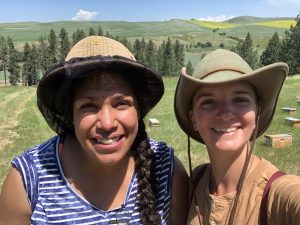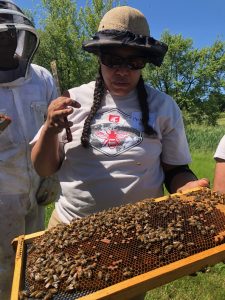Melanie Kirby

This summer I had the privilege of traveling to Pullman, Washington to interview Melanie Kirby of Washington State University (WSU) and Zia Queen Bees. Melanie is completing her Master of Science in WSU’s Apiculture department while running her own queen breeding operation in Washington (WA) and New Mexico (NM). Melanie generously shared her beekeeping journey with me.
Melanie fell into beekeeping by happy accident while on assignment in Paraguay as a Peace Corps volunteer. During her time in Paraguay, Melanie facilitated women’s groups, exploring tropical apiculture.
Melanie shares, “I was trying to help the women diversify their farming so that then they could have additional streams of income. We’d go out and catch these wild swarms from cocoa palms, and then transfer them into hives. There was a lot of citrus and sugarcane as well as different trees that were flowering so we’d get a good subtropical mix honey out of it there. It was really fascinating to see some of the women take to it.”
After the Peace Corps, Melanie travelled to Hawaii to study queen breeding at Kona Queen on the Big Island of Hawaii. Kona Queen is the largest queen producing honey bee operation in the world, producing over 245,000 queens a year. At Kona Queen, Melanie got a lot of practice with grafting — [a method that mimics the bees natural system of swarming to raise several queens at once in a synthesized environment]. It was here that Melanie realized, “Oh wow, this is a skill that’s needed and I can travel the world with it.”
Melanie continued her journey of working and learning in commercial beekeeping operations in both Hawaii and the continental United States before returning to her home state of NM to begin her own operation, “New Mexico is…a really unique state. It has everything from desert to tundra. It’s what we call a tri-cultural landscape. You have the Native Americans – the Pueblo Indians, the Apache, Picuris Indians as well as the Spanish and Europeans. Over time there has been a blending of these cultures who are also fighting to keep their distinct identities and learn how to coexist in a very diverse yet adverse landscape.”
Melanie shares with me that the Indigenous people of NM have always occupied their ancestral lands and they have developed Indigenous technology learned through trial and error on these lands.
“That is how these cultures have survived for thousands of years. Taos Pueblo is a community with these ancestral buildings which are over a thousand years old and somebody’s always lived in them. Always. Growing up where there’s these communities that have survived successfully for thousands and thousands of years, and the seeds that they saved for strains of chili, and the three sisters, corn, beans and squash – these crops that they were able to maintain and these seeds that they saved and then they’d pass them onto the next generation. It really made me recognize, ‘Well, that’s kind of similar to bees and these ecotypes.’”
There are 28 recognized subspecies of honey bees. They can all interbreed because they’re of the same species but the subspecies adapt to different bioregions and ecosystems based on environmental need.

In NM Melanie made the connection between bees and seeds, “Oh, the bees are seeds too and their stories, their historical capacities that have allowed them to do what they’re doing now have been formed over millennia. The genetic story that every organism carries with them can be passed onto the next generation. It’s like living proof of the past but also it’s already the future within itself. Just ready to evolve or adapt.”
Melanie’s work and research now centers on honey bee breeding selection in the United States, where honey bees are not endemic. Melanie researches strains of honey bees who can deal with various environmental stressors while still surviving and thriving. She trials bees in different areas and propagates them to share with other beekeepers. She also seeks out beekeepers who are doing similar types of “honey bee seed saving” to swap queen bees – the genetic “seeds” of a honey bee hive. Though Melanie already found bees marvelous, magnificent creatures breeding and swapping queens has made her realize how special each hive and its genetic makeup can be.
“I’m so glad they found me…I think a lot of the gratitude I have towards them is that they have really opened my eyes to just how interconnected we all are with not only each other but with our food, with our food system, with our land, with our soil, with our weather. They are a part of basically everything in some way, shape, or form through relationship. I can’t ever stop thinking about how interconnected they are and that is their allure.”
Media Attributions
- Mel Kirby and Angela Roell © Ang Roell is licensed under a CC BY-NC (Attribution NonCommercial) license
- Mel Kirby © Ang Roell is licensed under a CC BY-NC (Attribution NonCommercial) license


Feedback/Errata